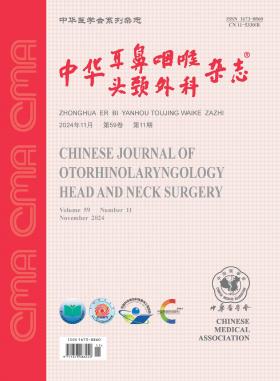[阻塞性睡眠呼吸障碍儿童认知功能的事件相关潜在评估]。
摘要
目的:应用事件相关电位(ERPs)评价阻塞性睡眠呼吸障碍(OSDB)患儿的认知功能损害。方法:本病例对照研究分析了2023年6月至2024年9月在清华大学北京清华长庚医院耳鼻喉头颈外科行腺扁桃体切除术的143例OSDB患儿(男94例,女49例,年龄9.0(7.0-11.0)岁)及17例健康对照[对照组:男10例,女7例,年龄10.0(7.5-12.0)岁]。根据多导睡眠图结果,将OSDB患儿分为轻度组[阻塞性呼吸暂停低通气指数(OAHI)≤5次/小时,男性49例,女性29例,年龄9.0(7.0-10.0)岁]和中重度组[OAHI指数(OAHI)≤5次/小时,男性45例,女性20例,年龄9.0(8.0-10.0)岁]。所有的孩子都完成了面部知觉整合任务。记录不完全面部刺激(S1)和完全面部刺激(S2)的枕部P100和顶叶、中央和额部P300分量。分析各组间振幅和潜伏期的差异。组间比较采用方差分析,两两比较采用独立样本t检验。非正态分布数据采用Mann-Whitney U检验进行分析。结果:(1)P100:轻度组[枕部P100振幅:O1-S1(12.44±5.96)μV,O2-S1(14.19±6.39)μV,O2-S2(30.34±11.30)μV]和中重度组[O1-S1(12.12±5.58)μV,O2-S1(14.08±5.48)μV,O2-S2(29.12±10.89)μV]均显著高于对照组[O1-S1(8.46±4.74)μV,O2-S1(9.68±3.70)μV,O2-S2(23.09±9.16)μV] (F=3.501, 4.486, 3.072,均P0.05)。两个OSDB亚组间无显著差异(P < 0.05),提示代偿性神经元亢进维持了正常的知觉功能。中重度组P100潜伏期[O2-S1(134.52±13.42)ms]较对照组[O2-S1(125.18±15.31)ms]显著延长(F=3.156, PP>0.05),提示重度患儿视觉加工延迟。(2) P300:轻度组顶叶区P300波幅[P4-S1(8.22±4.32)μV, P4-S2(17.67±9.42)μV]明显高于对照组[P4-S1(4.84±2.89)μV, P4-S2(13.19±7.23)μV] (F=7.19, 4.771, p < 0.05),提示轻度组警觉性降低。轻度组中央区P300潜伏期增加,但不显著(P < 0.05),提示注意反应速度可能降低。然而,中重度组的P300潜伏期[CZ-S1(394.18±89.12)ms]明显短于轻度组[CZ-S1(433.33±100.33)ms] (F=3.145, P0.05),这可能反映了在更严重的情况下,注意投入的代偿性增强。结论:OSDB儿童在初级视觉加工和注意调节方面表现出障碍,这可以通过ERP成分P100和P300的改变来证明。这些发现表明OSDB可能影响感觉统合和执行功能的神经机制。Objective: To assess cognitive impairment in children with obstructive sleep-disordered breathing (OSDB) using event-related potentials (ERPs). Methods: This case-control study analyzed data from 143 OSDB children[94 males, 49 females, aged 9.0(7.0-11.0) years] scheduled for adenotonsillectomy at the Department of Otolaryngology-Head and Neck Surgery, Beijing Tsinghua Changgung Hospital, Tsinghua University, between June 2023 and September 2024, along with 17 healthy controls [control group: 10 males, 7 females, aged 10.0 (7.5-12.0) years]. Based on polysomnography results, OSDB children were divided into a mild group [obstructive apnea-hypopnea index (OAHI)≤5 events/hour, 49 males, 29 females, aged 9.0 (7.0-10.0) years] and a moderate-to-severe group [OAHI>5 events/hour, 45 males, 20 females, aged 9.0 (8.0-10.0) years]. All children completed a face perception integration task. The occipital P100 and parietal, central and frontal P300 components of incomplete face stimuli (S1) and complete face stimuli (S2) were recorded. Amplitude and latency differences across groups were analyzed. Intergroup comparisons were performed using ANOVA, while independent samples t-tests were used for pairwise comparisons. Non-normally distributed data were analyzed using the Mann-Whitney U test. Results: (1) P100: Both the mild group [occipital P100 amplitude: O1-S1(12.44±5.96) μV, O2-S1(14.19±6.39) μV, O2-S2(30.34±11.30) μV] and moderate-to-severe group [O1-S1 (12.12±5.58) μV, O2-S1 (14.08±5.48) μV, O2-S2(29.12±10.89) μV] showed significantly higher amplitudes than the control group [O1-S1(8.46±4.74) μV,O2-S1(9.68±3.70) μV,O2-S2(23.09±9.16) μV] (F=3.501, 4.486, 3.072; all P<0.05). No significant differences were found between the two OSDB subgroups (P>0.05), suggesting compensatory neuronal hyperactivity maintaining normal perceptual function. The moderate-to-severe group exhibited significantly prolonged P100 latency [O2-S1 (134.52±13.42) ms] compared to controls [O2-S1 (125.18±15.31) ms] (F=3.156, P<0.05), while no significant difference was observed between the mild group and either the control or moderate-to-severe groups (P>0.05), indicating delayed visual processing in severely affected children. (2) P300: The mild group exhibited significantly higher P300 amplitudes in parietal regions [P4-S1(8.22±4.32) μV, P4-S2(17.67±9.42) μV] compared to controls [P4-S1 (4.84±2.89) μV, P4-S2 (13.19±7.23) μV] (F=7.19, 4.771; both P<0.05), whereas no significant differences were observed between the moderate-to-severe group and either the control or mild groups (P>0.05), indicating mild group reduced alertness. The latency of P300 in the central region showed an increase in the mild group, although not significantly (P>0.05), indicating a potential decrease in attentional response speed. However, the moderate-to-severe group demonstrated significantly shorter P300 latencies [CZ-S1(394.18±89.12) ms] compared to the mild group [CZ-S1 (433.33±100.33) ms] (F=3.145, P<0.05), possibly reflecting compensatory enhancement of attentional engagement in more severe cases. Conclusion: Children with OSDB exhibit impairments in primary visual processing and attentional regulation, as evidenced by altered ERP components such as P100 and P300. These findings suggest that OSDB may affect neural mechanisms underlying sensory integration and executive functioning.

 求助内容:
求助内容: 应助结果提醒方式:
应助结果提醒方式:


